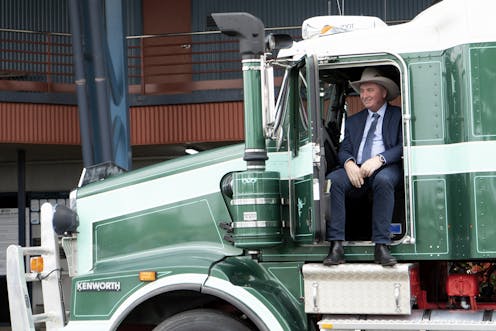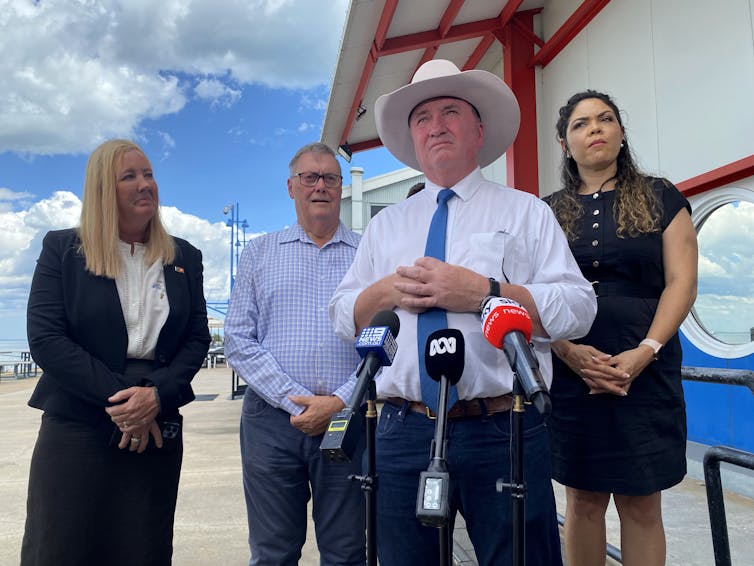
While the Liberal and Labor parties each face several nail-biting contests, the Nationals have fewer immediate concerns in this federal election.
The party has good prospects of retaining most, if not all of their House of Representative seats and gaining an additional senator. Half of their 16 lower house seats have margins of more than 15% and the remainder are considered safe to very safe.
But this does not mean there will be post-election peace and leadership stability in the Nationals’ party room. Queensland senator Matt Canavan’s latest intervention on climate change also shows the Coalition’s internal “climate wars” are not over.
The central Queensland battleground
There are three seats in central Queensland that Labor has won at least once over the past 15 years, but they all swung heavily to the Liberal National Party in 2019.
Self-appointed party maverick George Christensen is retiring as the MP for Dawson to be a One Nation Senate candidate (but has been allocated an unwinnable position on that ticket). The new Nationals candidate, tomato farmer and Mayor of Whitsunday Council Andrew Willcox, has the right kind of profile and inherited margin of (14.6%) to hold the seat.

To the south, Capricornia was very marginal heading into the last election. But sitting MP Michelle Landry now has a buffer of 12.4% and should be able to hold on. Further south, Flynn has the lowest margin (8.7%) of all Nationals’ seats and Ken O’Dowd is retiring. But the new Nationals’ candidate, Colin Boyce, has a regional profile as a local and state politician.
There is an interesting contest in the very safe seat of Hinkler (14.5%), with Jack Dempsey, the mayor of Bundaberg Regional Council and former state minister in the Newman government, challenging Resources Minister Keith Pitt. Dempsey is running as an independent and now seems somewhat to the political left of Pitt.
In 2019, in all four of these seats, the Nationals candidates benefitted from strong preference flows from minor parties and independents, with One Nation especially enjoying significant support. Minor party votes and preference flows for this region are therefore something to watch on election night.
Threats and opportunities
A possible risk for the Nationals is the central Murray River seat of Nicholls in Victoria. Here the threat is from the Liberal candidate, teacher and farmer Steve Brooks, and perhaps even independent candidate business owner and Shepparton Councillor, Rob Priestly. This follows the retirement of National Party Whip Damien Drum. Each of the Coalition partners has held this seat, so this is shaping up as a three-cornered contest. Water policy is an issue in this region.
As is usual over the past 20 years or so, the Nationals are highly focussed, contesting only a handful of seats they do not hold. To the east of Nicholls, the Nationals would like to gain Indi, but they would need to beat the incumbent, independent Helen Haines, and the Liberals, who held this seat from 1977 to 2010.
They are nominally competitive in Hunter in NSW, with Labor’s Joel Fitzgibbon retiring and a margin of only 3%, due to a big swing against Labor in 2019. One Nation also polled well (20+%) in Hunter in 2019. The results in Hunter and the central Queensland seats may be some indication of whether pro-coal positioning – now broadened to more general energy issues – has resonance, given the Coalition is formally on the net-zero wagon.
Former local politician Bryce Macdonald is contesting the northern Queensland seat of Kennedy. But former National Bob Katter holds this on a 13.3% margin and is expected to retain the seat he has held since 1993.
The northern NSW seat of Richmond is a former Country Party stronghold, now nominally a marginal Labor seat but the “lifestyler” influx works against the Nationals in that region (which includes Byron Bay). There are also Nationals candidates for Durack (WA) and Barker (SA), but these will almost certainly be retained by the Liberals.
The Nationals and the Senate
This election may see the Nationals welcome its first Indigenous senator in Jacinta Nampijinpa Price, who is leading the Country Liberal Party’s (CLP) Senate ticket for the Northern Territory (assuming she chooses to sit with the Nationals in Canberra). She replaces Sam McMahon, who sat with the Nationals but then quit the CLP in January after internal disputes.

McMahon is now standing as a Liberal Democrat candidate. Former NSW Nationals director Ross Cadell is second on the joint party ticket for NSW and should be elected as an additional Nationals senator, despite some adverse publicity at the time of his preselection.
The campaign and beyond
As the campaign progresses, look for three things from the Nationals that reveal much about the operation of the Coalition.
The first is double messaging – one of unity with the Liberals at joint events and under the eye of national media, with much more “independent” messages on the wombat trail.
Read more: The National Party used to be known for its leadership stability — what happened?
Especially watch for qualification of the net-zero commitment and leveraging of the Ukraine situation to support the continuation of coal mining. This has been particularly evident in comments by Canavan last week who said, “the net zero thing is all sort of dead anyway”. As he campaigns in Flynn, Boyce has also been talking about “wiggle room”.
Secondly, there will be limited invitations for Prime Minister Scott Morrison, or any senior Liberal, to join the Nationals on the campaign trail, with the notable exception of visits to Hunter. They will be distancing themselves from the Liberal brand – Morrison does not have the currency in the bush that he did at the last election, due to both general shifts in perception and particular instances around disaster management for fire and floods.
Thirdly, there will be a focus on the Nationals’ success in extracting concessions from the Liberals during the last term, notably an agreement for construction of two dams in Queensland. As the former Liberal MP, the late Bert Kelly used to say, “at each election I can feel a dam coming on”.

Finally, there are some interesting possibilities in regard to the post-election National Party. A minority Coalition government could see the Nationals having to be civil to some urban, teal independents, while an outright loss would open up leadership speculation.
In 2007, both Coalition leaders resigned after the election, though Warren Truss continued as leader after the narrow 2010 loss. Even a clear Coalition win will not necessarily secure Joyce’s leadership of the party. The intersecting divisions based on geography (north versus south), personalities and attitudes to climate change policy remain.
Joyce’s support has been bolstered by perceptions of him as standing up to the Liberals and being an effective retail politicians. Both those things will be tested during and after the campaign.
Geoff Cockfield does not work for, consult, own shares in or receive funding from any company or organization that would benefit from this article, and has disclosed no relevant affiliations beyond their academic appointment.
This article was originally published on The Conversation. Read the original article.






